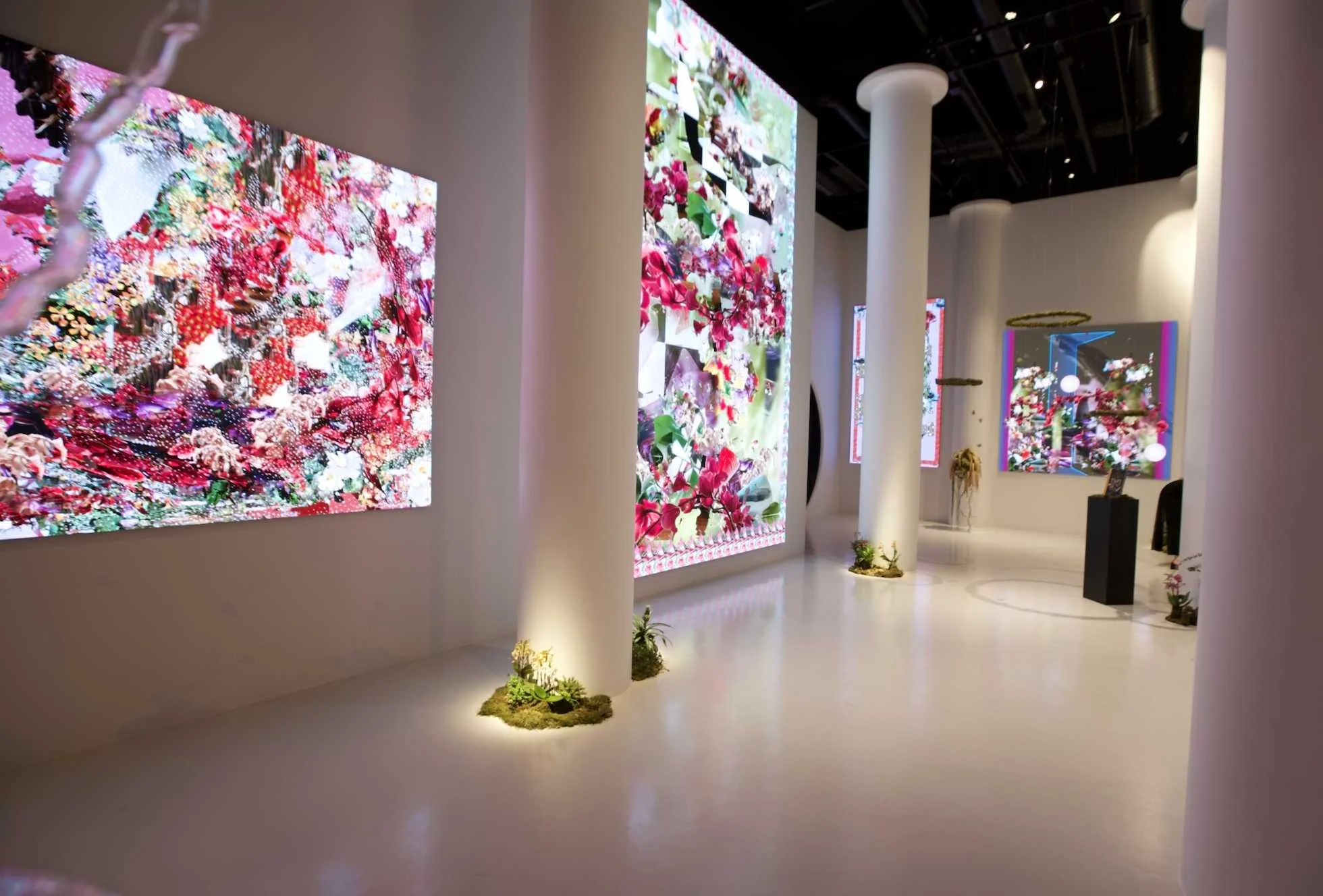CIFRA World
CIFRA’s origin story starts with one simple truth: ultracontemporary art never sits still. AI is the artist’s new sidekick, and tech tools are reshaping everything—from video performances to sound installations and even traditional media. The old art world rulebook needs to be rewritten or at least digitized. And CIFRA’s doing just that. This new digital platform is trying to change how people perceive, experience, and interpret art that is relevant here and now when the world is on fire (literally and figuratively).
Sure, they’re at professional events such as Ars Electronica and LOOP Barcelona, but they’re also throwing raves, hosting experimental art labs in random corners of the globe, and building a platform for art as a playlist-driven experience. Yes, playlists—because who says art can’t feel like mixing your favorite music into a story? Their mission is simple but huge: reimagine our collective future in a world that is constantly glitching.
A brutalist loft-turned-club in an eclectic hotel in Dubai. It’s 30 degrees outside, but inside, it’s even hotter. Two artists on stage mix audio and visuals in real time. Pulsing beats, hypnotic projections, a crowd vibing like it’s Berlin. Behind the decks is Amir B Ash, experimental filmmaker and co-director of MUTEK.AE, and Safeya Alblooshi, a sound artist whose work has already been presented at the Louvre Abu Dhabi.
Then After 12 Collective—a crew of insanely talented Omani guys, who look like they’re all in their 20s— takes the stage, starting a full-blown rave. A neon sign glows on the wall: Art Breaks My Heart in Pixels. Eco-friendly frames made of electronic waste display works like Lorenzo Mason’s endless sunsets or Harshini J. Karunaratne’s siren. This isn’t just a media art exhibition. Or at least not as what we’re used to.
CIFRA launched mid-NFT boom, back when digital art was often reduced to flashy GIFs and JPEGs sold for millions. But the platform had a different vision: break those stereotypes and show that digital art was more than just Web3 hype. It’s been evolving since the ’80s, with the internet amplifying its reach—though it was never meant to exist solely online. Art still needs to hit you in real life, where you can truly feel its impact.
“We didn’t just want to be a streaming platform,” says Polina Orekhova, CIFRA’s Head of Marketing. “We wanted to be a rich archive—a treasure trove of unconventional art that dives deeper than surface-level clicks. Think sound art, site-specific installations, and works that tackle urgent, global issues. For CIFRA, it’s about artists’ voices—stories from places like the Middle East, Northern Africa, or China—offering perspectives that hit hard.”
CIFRA’s mission isn’t to replace the experience of a traditional museum or gallery—it’s more about making new media art spark curiosity, and in turn, inspiring people to check out in-person exhibitions. From their Gentle Tremor video screening program in Barcelona, showcasing works by Asian artists, to Floating Cinema in Venice and sound performances in Dubai giving a platform to young talents from the Gulf, CIFRA is all about making art accessible everywhere.
Today, CIFRA’s platform boasts around 1,500+ artworks across 50+ genres. This isn’t about bridging the gap between cultures and movements—it’s about ultimately transcending borders. Take Rhett Tsai’s curated playlist, The Ghosts of Avant-Garde, spotlighting young Chinese artists reinventing media art through AI, AR, and games. Avant-garde is and has never been just an aesthetic; it’s a mindset.
Olga Shishko, Head of Art at CIFRA, says the avant-garde isn’t here to toy with reality but to reinvent it. “The artists we work with don’t rewrite the rules; they ditch the rulebook entirely. This generation is shaped by AR, interactive games, and AI—not VHS tapes or video art. They’ve mastered tech like second nature, diving deep into the subjects of wars, virtual currencies, and digital waste, turning their realities into immersive, game-like performances, where the artist’s voice is amplified and augmented to tell the ultimate truth—sometimes ahead of its time.”
For example, Ziyang Wu’s Where Did Macy Go? is an 11-episode series, exploring urbanization and COVID-era societal shifts through short, cutting-edge videos that originally was published on TikTok because desperate times take desperate measures. Meanwhile, Weidi Zhang’s ReCollection uses AI to reconstruct Alzheimer’s patients’ memories—a haunting and poetic use of neural networks.
Last November еhe platform gave its CIFRA Award (yes, CIFRA supports talents all over the globe with grants) to Regina José Galindo, a Guatemalan artist for her performative piece Siren. 12 auto mechanics meticulously dismantle a police car while Galindo sits unwavering in the backseat. Galindo is famous for her fearless performances, consistently challenging societal norms, and speaking up against oppression. Olga Shishko says “Regina José Galindo isn’t here to make us feel comfortable. Her art dives straight into the violence, discrimination, and human rights abuses and forces us to deal with the ugly truth. But she speaks in a universal way that cuts through the noise, which is why we couldn’t pass by with our CIFRA Award this year. In a world where it’s getting harder and harder to get real messages out thanks to fake news and populist agendas, Galindo's work is a shot of truth that can't be ignored.”
"Our CIFRA Award is the initiative we’re most proud of," says the team. "It’s not just about numbers or stats; we focus on supporting projects that make an impact. The award is a nomadic nomination at its core—a few times a year, the platform pops up at global art events like LOOP Barcelona and selects one artist whose work makes a statement about what’s going down in the world.”
In 2023, the award went to Louis Cyprien Real’s Babel, a modern take on the Babylon story, where passages from Genesis are translated and read aloud using AI programs DeepL and ElevenLabs. AI’s a huge focus for CIFRA—they dedicated an entire season to it on their platform, bringing in big names like Boris Eldagsen, Lev Manovich, and Rebecca Pedrazzi who are using advanced tech in their creative practices. The platform isn’t ignoring the risks that come with AI’s rise though but trying to start bigger discussions around its potential and the controversies that come with it.
At CIFRA, they get that in today’s art world two things matter most: being heard and being found. The platform supports artists by offering an open, accessible ecosystem where they can earn royalties for streaming their pieces. It’s free to sign up—register, showcase your work, and tell your story. Curators and other art professionals get a front-row seat to fresh talent, collaborators, and new ideas. And through streaming artists can earn royalties, supported by a fund from subscription contributions.
The team believes in sharing the stories behind the projects they back and puts a lot of resources into art mediation. "These are the voices that matter—they speak to us through their bold themes, innovative approaches, and the emotional depth they bring to global conversations." And it’s not just about celebrating what’s happening now, but pushing the envelope on how we see the future of art.”
As Polina Orekhova puts it: "The artists we feature and the curators we work with—whether it’s Emirati artists like Safeya Alblooshi and Moza Almatrooshi, or voices from the Chinese art scene like Axl Le and Rhett Tsai—embody our core values. It’s all about vision, innovation, and the boldness to tackle the hard-hitting questions."
It’s not just about the art—it’s about the context too. Through CIFRA TV, the platform’s own video production, they’re giving audiences a behind-the-scenes look at the stories, the process, and the deep dives into the work itself. It’s about showing the grind—the hours of research, inspiration, and pure ambitions and emotions that turn ideas into art.
"We don’t just want to showcase art," Orekhova continues. "The real goal is to nurture empathy and broaden perspectives. Maybe that sounds optimistic given the state of the world right now—but the more we learn about each other’s experiences, the better chance we have at becoming more compassionate."
The CIFRA art program isn’t static—it’s built around thematic seasons that change every few months. This year kicked off with a season dedicated to AI. With all the hype and drama surrounding AI these days, CIFRA is giving a voice to artists themselves, letting them show how and why they use new tech in their practice.
And it all makes sense now: why host performances in the desert, why make their art award nomadic, why change seasons—because ultracontemporary art never sits still. Neither does CIFRA.
What to read next



















